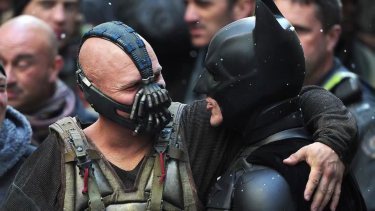Matthew S. Williams's Blog, page 195
July 23, 2012
Winston Agonistes, Part IV
Welcome back! You know, it feels like I’ve been a little wan in my output lately. Perhaps it’s because I’ve been hard at work on my stories… or not. Hard to say really, but I will say that the anthology me and my colleagues have been working on is coming along nicely! In an attempt to keep pace with my group, I’ve come up with another installment in the Winston Agonistes story.
And just for fun, much of this installment was inspired by real-life tales of Shàngdū, China. It is this ruined city that was once the summer capital of the Yuan Dynasty, as decreed by the Mongol ruler Khublai Khan. Often referred to as Xanadu or Sanadu (in Mongolian), this city is the same place that is mentioned in Marco Polo’s account of China, the one which inspired European dreams of traveling to the Orient and finding cities of gold. It also inspired the poem “Kubla Khan” by Samuel Taylor Coleridge and a musical which I will not get into, even to save my own life!
Anyway, here it is, fresh from the press. Behold!
As expected, a greeting party was waiting for them in the Transport Bay. Dressed in their ceremonial robes and wearing pressure masks, they stood on the platform overlooking the main deck. Winston eyed them through the cabin window as their ATV came to a complete stop, noting the individuals and their respective positions from the mantles they wore.
There were five in total, arranged by twos around the one in the middle who wore the most flamboyant garb of all. The ladies he denoted by the choice of red robes, while the males wore the traditional blue, consistent with Shiangdu’s code of customs. Aside from that, there was only a single distinction, which came in the form of the orange inlaying that the man in the center had on his robe. That could be none other Commissioner Yan Moon Kim, Wu’s second in command.
The seals disengaged and the door opened. The top segment rose above the ATV’s roof while the bottom one lowered to form their exit ramp. Winston allowed the Councilors on the other side to file out first and fitted his helmet, which at this point in their mission had remained unused, over his head. Though the Shangdu settlers were no strangers to synthetics, their reaction to seeing one in the capitol’s delegation could not be fully predicted.
As their team filed into the bay, the Shangdu representatives climbed down the steps to the deck to meet them. Handshakes were exchanged between Kim and Mutlu, Kim gesturing to the pressure doors immediately thereafter so that further pleasantries could be conducted without the need for helmets. Mutlu nodded and they marched together, mounting the steps and entering through the cycling doors that would lead them within.
Winton looked back upon the bay, noted the deck hands that began to pour over their ATV. As a courtesy, they refueled the vehicle, removed the excess traces of fungal deposits from its wheels, and packed them away in biohazard containers. Some of the tendrils looked rather large this trip.
The pressure doors opened, admitting them into a small vestibule located next to the main colony. Much like all decontamination bays, the walls were studded with sensors, vents and irradiation panels, all of which became active as soon as the doors closed behind them. Many in their crew drew a hand to their face to cover their visors, protection against the onset of the harsh lighting that began to fill the confines of the room. Winston needed no protection, as his eyes adjusted automatically to the onslaught of the harmful rays. In a few seconds, it was over. All airborne pathogens that had clung to their shells rendered completely inert.
The harsh lights disappeared and were replaced by a green glow. The interior doors began to slide open slowly. Beyond, the grey paneling of the entrance hallway appeared and the Shangdu welcoming committee stepped out and ushered the rest of them forward.
Winston could not help but think this was a momentous occasion. It would be the first time he had ever witnessed a colony outside of Zarmina. He had conducted all the research necessary to prepare himself for the trip. He knew the interior layout of the colony well and the significance of every detail contained within. And yet, to actually see it for himself seemed beyond compare.
We’re he able to describe the situation; the word exciting would certainly come to mind. If only he were capable of truly feeling that.
* * *
They came to it at last, the doors that led into the settlement proper, where the expectation of excitement would certainly be at apogee. Winston had learned from his many archival studies on emotions that it was in the last moments before the reveal that feelings of anticipation reached their highest, in what was described as a fever’s pitch. It was fortunate then that he did not feel such feverish emotions, otherwise he might not have noticed the fine details that were in front of him.
The colonies main doors, for example. Constructed of a crystalline-polymer composite, they were clearly meant to resemble a marble gateway that had been etched with classical motifs from the late Yuan Period. And in keeping with the design of the original city, the colony had been laid out in four-quadrants with mayoral palace towards the center-rear, though the layout was circular instead of square. Such a profile would never support the settlements enclosed nature, which invariably required some degree of revision to the original plan.
The doors slid open and Winston’s eyes shifted to long focus, every detail being absorbed as it became clear. He was immediately aware of lush greenery and emerald color schemes, of gilded columns and carved surfaces. A few meters from the doorway, a second party of three people who also ornately dressed, stood and waited for them. In the exact center, dressed to resemble a Manchu-dynasty tyrant, no doubt, was Wu himself. Their greeting party of five joined his, forming a perfect eight.
“Councilman, I am honored,” Wu said in a strained, lightly accented voice. Mutlu stepped forward and bowed gently towards him.
“Mayor Wu, the honor is mine.” Wu returned the gesture and they came together to exchange kisses on each other’s cheeks. The initial exchange was going well, respect being given for each leader’s particular cultural niceties. Winston began to wonder if his request for a seat at the meeting was more or less likely to succeed at this point.
More conversation followed as they walked down the length of the settlement’s main foyer, into what appeared to be a preserve featuring various Terrestrial plants. A path of what resembled cobbled stone stretched out before them, stretching to the far end of the enclosure where the city itself would be accessible. For all newcomers to the settlement, this was the first thing they would see as they made their way into the vast collection of marketplaces, tenements, facilities, and of course, the mayoral palace at the far end.
As they walked, Winston’s olfactory receptors noted the presence of cherry blossoms and plum trees, his eyes detecting the bright colors of birds of paradise plants and even animals prancing about. Most impressive amongst these was the Pelicans that were drinking by the small creak running through the enclosure.
Winston turned to Bhutto next to him. “Synthetics?” he asked. Bhutto looked in the direction he was pointing and shook her head.
“No Winston, those are real. The settlers arranged for ova and sperm to be stowed in their supplies well in advance.”
He looked back at the animals as they continued to graze and drink from the artificial creek. It seemed unlikely that organic creatures would have been transplanted here, given the cost to bread them and added upkeep. And yet, he was being told to believe this very thing. And for a moment, he considered the possibility that what he was experiencing the emotional state known as confusion. Another unlikelihood.
His attention returned to Bhutto when she playfully slapped his arm.
“Imagine that, a synthetic that can’t tell the different between organic and synthetics.”
Wilson smiled obligingly. “For that, you will have to blame the makers, madam. They do their work too well.”
She laughed again and placed both hands on his arm. He registered a gentle squeeze through the layers of his sleeve. His calculated jocularity appeared to be having an interesting effect. In addition to entertaining the Councilor, he was almost sure she was beginning to… like him.


Terraforming in Pop Culture
Welcome back to the wonderful world (pun!) of Terraforming. In my last post on the subject, I came to see that it emerged in fiction in the early 20th century as part of our growing awareness of the universe and humanity’s place within it. As western civilization grew and came to encompass the entire world through exploration, conquest and colonization, human scientists simultaneously discovered that our universe was much larger than previously thought, and began to postulate that life could exist on other planets.
In short, while our world grew smaller, the universe grew much, much larger. With no more nooks or corners left to explore and conquer, we began to set our sights to the heavens for the next frontier. It’s such a fertile topic, but I shan’t get into it here. If I start waxing philosophical on all the thought that goes into exploring new worlds, we’ll be here forever.
Onto to the subject for today, which is terraforming in popular culture! As you can guess, there are quite a few instances of this taking place, and for good reason. Wherever science fiction and exoplanets have shown up in pop-culture, the concept terraforming was sure to follow. In some cases, this constituted a mere mention, but in others, detailed descriptions were given. Here is a list of just a few examples that I could find:
Aliens: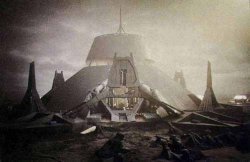 Central to the plot of Aliens was the fact that LV-426, the planet where the Nostromo and its crew encountered the Xenomorph in the first movie, had become a settler colony. As the executive at Weyland Yutani told Ripley, it was what they referred to as a “Shake and Bake Colony”, where terraformers were sent on ahead to run the atmospheric processors and make the planet suitable for human use. This was all in keeping with WY’s motto of “Building Better Worlds”. Pshaw!
Central to the plot of Aliens was the fact that LV-426, the planet where the Nostromo and its crew encountered the Xenomorph in the first movie, had become a settler colony. As the executive at Weyland Yutani told Ripley, it was what they referred to as a “Shake and Bake Colony”, where terraformers were sent on ahead to run the atmospheric processors and make the planet suitable for human use. This was all in keeping with WY’s motto of “Building Better Worlds”. Pshaw!
Shortly after they arrive on LV-426, Ripley and the compliment of Colonial Marines determined that the colonists had been moved into the atmospheric processor, specifically to its lower levels where the air was hot and humid. Apparently, these conditions were favorable to the Xenomorph hatchlings, which began to use the colonists as hosts to breed”Chestbusters”.
After their disastrous confrontation in the hive, the atmospheric processor suffered a rupture to its coolant systems, which meant that the entire thing would go thermonuclear in just a few hours. After being all but eradicated in their first encounter with the Xenomorph and losing their only transport back to the ship, this served to add further urgency to the plot. And in the end, it was the destruction of the atmospheric processor which ensured that the Xenomorph colony was destroyed and all traces of them (with the exception of the Queen) wiped out.
Cowboy Bebop: Set in the not-too-distant future, this anime from from the late nineties was set in a universe where humanity lived throughout the Solar System. This was made possible due to the discovery of hyperspace gates; however, due to the explosion of one near the Moon, Earth found itself being bombarded by meteorites which devastated large sections of the planet. As a result, much of the human race had to relocate to the Inner Planets, the Asteroid Belt, and the moons of Jupiter.
Set in the not-too-distant future, this anime from from the late nineties was set in a universe where humanity lived throughout the Solar System. This was made possible due to the discovery of hyperspace gates; however, due to the explosion of one near the Moon, Earth found itself being bombarded by meteorites which devastated large sections of the planet. As a result, much of the human race had to relocate to the Inner Planets, the Asteroid Belt, and the moons of Jupiter.
Many episodes of the show take place on the planets of Venus, Mars, Ganymede, Io, Callisto, and Titan, where terraforming has rendered them partially of fully habitable. Though the concept is treated as a sort of given, some degree of explanation is given as to how it took place and the varying degrees of success that resulted. In the case of Mars and Venus, the terraforming was so successful that Mars became the new hub of human civilization and Venus a major population center.
With this background firmly in place, the series plot arc – which involves a motley group of bounty hunters patrolling the system Space Western style – is then able to unfold. Though the show last only 26 episodes, it did achieve a cult following and a level of influence, similar to Joss Wedon’s Firefly (another Space Western that died prematurely).
Firefly: Speak of the devil, or in this case, a show that made good use of the concept of terraforming. Intrinsic to the plot of this show, so much so that they opened every episode by referring to it, is the fact that in this future, the human race was forced to relocate to a new star system after Earth had been “used up”. Arriving at the “White Star”, they found dozens of planets and hundreds of moons around the system’s central sun and its many dwarf suns. These planets were then terraformed, a process which took generations, and began populated them soon after.
Speak of the devil, or in this case, a show that made good use of the concept of terraforming. Intrinsic to the plot of this show, so much so that they opened every episode by referring to it, is the fact that in this future, the human race was forced to relocate to a new star system after Earth had been “used up”. Arriving at the “White Star”, they found dozens of planets and hundreds of moons around the system’s central sun and its many dwarf suns. These planets were then terraformed, a process which took generations, and began populated them soon after.
Another fact which is central to the story is the fact that while the central worlds were terraformed successfully and boasted large, advanced populations, the outer planets were poorly terraformed, leading to dry, desolate worlds that became havens for crime and backwards populations. Though life was show to be difficult in these colonies, they were also the only places where people can still enjoy a life free of the repressive Alliance regime.
But more importantly, this back story gave Joss Whedon an excuse for the look and feel of his acclaimed Space Western! It also played perfectly into the show’s historical narrative, where the expanding Alliance represented the closing of the American frontier and the death of a way of life. For not only were the First Nations and their culture being sacrificed in the name of “Manifest Destiny”, a great deal of the American Dream of an open frontier was as well.
Red Planet: Set in 2056 AD, the plot of this film centers around ongoing terraforming efforts on Mars. Faced with the dual problems of overpopulation and pollution, NASA and other space agencies begin sending automated probes to Mars that contain atmosphere-producing algae. These probes have been seeding Mars for twenty years as the first stage in a terraforming effort that will make the planet suitable for human settlement. When the oxygen production is inexplicably reduced, a crew is sent to investigate so that the terraforming efforts can be put back on track.
Set in 2056 AD, the plot of this film centers around ongoing terraforming efforts on Mars. Faced with the dual problems of overpopulation and pollution, NASA and other space agencies begin sending automated probes to Mars that contain atmosphere-producing algae. These probes have been seeding Mars for twenty years as the first stage in a terraforming effort that will make the planet suitable for human settlement. When the oxygen production is inexplicably reduced, a crew is sent to investigate so that the terraforming efforts can be put back on track.
When the mission arrives, and endures numerous disasters,they eventually discover that the introduction of Earth algae has stirred up the native Martian life. This consists of nematodes that have come to the surface to feed on the algae, emitting oxygen in return. This, they realize, has changed the parameters of the original project, but leaving it otherwise intact.
Star Trek II and III: What is generally hailed by fans as the best movie of the franchise (Wrath of Khan) opens up with a rather unusual take on terraforming. In fact, the plot of both the second and third movie revolve around a project known as Genesis, a means of instantaneously transforming a planet from a lifeless husk into a habitable M-class planet.
What is generally hailed by fans as the best movie of the franchise (Wrath of Khan) opens up with a rather unusual take on terraforming. In fact, the plot of both the second and third movie revolve around a project known as Genesis, a means of instantaneously transforming a planet from a lifeless husk into a habitable M-class planet.
In Wrath of Khan, things begin when the starship Reliant, while searching for a lifeless planet in the Ceti Alpha system, is taken over by Khan Noonien Soong and his band of genetically-modified people. Having learned of their mission, Khan becomes obsessed with finding the Genesis device so that he can restore the desolate landscape of Ceti Alpha V, presumably with the intention of resurrecting his dead wife.
In the end, Kirk and the Enterprise disable his ship inside a nebula, prompting Khan to set the Genesis device to self-destruct in the hopes of taking Kirk with him. With their warp drive non-functional, the Enterprise could not escape, prompting Spock to sacrifice himself in order to bring the engines back online. Though he dies from radiation poisoning, the ENterprise escapes as the Genesis device detonates, which has the effect of turning the nebula itself into an M-Class planet.
At the very end of the movie, Spock’s body is placed inside a torpedo casing and fired into orbit around Genesis. After landing on the surface, the “Genesis wave” heals Spock’s body and he is reborn. This, as all fans of the franchise know, was the basis for the third movie where Kirk and the Enterprise come back to Genesis to retrieve him. In the course of doing so, the Genesis plant is examined in more detail and the effects of the project. Ultimately, though the device was capable of creating life out of lifeless, it proved unstable and resulted in the total collapse of the planet created.
Total Recall: The film adaptation of Philip K Dick’s “We can Remember it for You Wholesale” differed from the source material in many key ways. For example, in addition to the central theme of memory and the dividing line between real and artificial, there was also an extensive backstory involving Mars. Ultimately, the character of Quad (played by Arnold Schwarzenegger) learns that he is drawn to Mars because that is where he is from, and his false identity implanted because of something he witnessed there.
The film adaptation of Philip K Dick’s “We can Remember it for You Wholesale” differed from the source material in many key ways. For example, in addition to the central theme of memory and the dividing line between real and artificial, there was also an extensive backstory involving Mars. Ultimately, the character of Quad (played by Arnold Schwarzenegger) learns that he is drawn to Mars because that is where he is from, and his false identity implanted because of something he witnessed there.
In the end, it is revealed that this secret has to do with an ancient alien device that lies at the heart of the planet, a device which has the power to terraform Mars into a habitable world. Apparently, this involved some super-heated coils that, when activated, would plunge into the planet’s watery core, evaporating them and filling Mars’ atmosphere with water vapor. When Quad activated the device, it had the effect of creating breathable atmosphere within a matter of minutes.
Not the most realistic depiction of terraforming, but it did have it’s upsides. For one, it took advantage of contemporary scientific theories that stated that Mars might have underground sources of water and ice. Second, it incorporated speculation of how these could be used to eventually create oxygen-creating plants on the surface and hence, an atmosphere. Last, it worked into the plot in that the villain, Coohagen, knew that if Mars had a natural atmosphere, it would destroy the basis of his power (controlling the air supply).


July 22, 2012
Shatner’s “Get A Life” Explores Star Trek Fandom
In 1986, William Shatner hosted Saturday Night Live and performed the sketch where he told a convention of Trekkers to “Get a life!” A hilarious moment in television history, or an instance of carefully scripted sincerity? Who knows? Either way, anyone who has not checked seen the sketch should do so immediately. I’ll wait, don’t worry…
Wasn’t that hilarious?
Anyway, it just so happens that Shatner is back at it, trying to find out what it is that defines Trekkies and contributes to the phenomena known as Star Trek fandom. Appropriately, he has named this movie “Get A Life” in honor of the satirical remarks he made on SNL. Again, this may or may not be sincere advice. The point is, even after decades of being the big name is Star Trek, he still wonders why the hell grown men and some grown women have spent their entire lives dedicated to this franchise.
Following in the same vein as Trekkies, this documentary goes beyond taking a look at Star Trek conventions and fandom over the years and delves into the deeper questions of what makes Star Trek so enduringly popular. Much like Star Wars, it’s a science fiction franchise that has become inextricably embedded in our collective consciousness, to the point that even Captain Kirk himself is astounded and left wondering what the hell is going on…
Snippets from the documentary suggest that it was Roddenberry’s optimism that won fans over. His positive view of a future where all our current ills are solved and the worst didn’t happen is certainly one of the a selling points of the franchise. With so many dystopian and misanthropic visions permeating the pop culture sphere, people enjoy hearing a more positive appraisal of humanity and its prospects.
More echoes of Star Wars there, another franchise which captured fans imagination with its upbeat message and tempo. One has to wonder if the timing of these two franchises wasn’t just the slightest coincidental…
Anyhoo, here is the documentary’s official trailer. Enjoy!



July 21, 2012
New “Man of Steel” Trailer!
 Behold! In the wake of this years’ Comic Con, it seems that trailer fever has struck. I, being a geek and hence unimmune to such strains of fever, am making it a point to post the updates. Here’s the most recent trailer from the upcoming Superman relaunch “Man of Steel”, which was first announced at Comic Con during preview night.
Behold! In the wake of this years’ Comic Con, it seems that trailer fever has struck. I, being a geek and hence unimmune to such strains of fever, am making it a point to post the updates. Here’s the most recent trailer from the upcoming Superman relaunch “Man of Steel”, which was first announced at Comic Con during preview night.
In this updated preview, we get a glimpse of the new Clark Kent (Henry Cavill), his father (played by Kevin Costner), and a scene of him with his Superman cape breaking the sound barrier. And of course its all done to a sort of “set the scene” narrative which establishes the coming of age nature of the movie, much like the “with great power comes great responsibility” speech Peter Parker’s uncle gave him in Spiderman.
Aside from that, this preview is pretty damn spares. Clearly, the studio is taking the eye drop approach, releasing tiny little clips to tease and taunt the audience into demanding more. By comparison, Robocop - another relaunch which first previewed at Comic Con – appears to be taking the Prometheus approach: doing mock ads and context pieces in order to establish background. Personally, I like the latter approach better. It promises that there will be debt to the franchise and more than just a bildungsroman about a central hero.



July 20, 2012
Astronomers Confirms The Existence of Habitable Exoplanets!
 Wow! It’s fun and amazing when things line up like this. According to IO9, astronomers have confirmed that there are two exoplanets that may be habitable, which will come in handy when the human race begins looking for new planets to colonize. Officially, these planets are known as Gliese 581 g and c, which orbit a star system located roughly 20 light years from Earth.
Wow! It’s fun and amazing when things line up like this. According to IO9, astronomers have confirmed that there are two exoplanets that may be habitable, which will come in handy when the human race begins looking for new planets to colonize. Officially, these planets are known as Gliese 581 g and c, which orbit a star system located roughly 20 light years from Earth.
Can you say coincidence? By now, just about everyone who reads my blog knows that myself and a group of writers are hard at work producing an anthology about the colonization of a distant world in the not-too-distant future. Well guess where it’s set? Gliese 581-freaking-g! That’s where! Yes, in the course of researching realistic locations for our story, Mr. Goran Zidar suggested we use this star system seeing as how it is known to have a system of planets.
After doing our due diligence, we learned that two planets are deemed habitable by human standards, Gliese 581 g and c. And of the two, g is the prime candidate for settlement, being the closest in mass, surface temperature and gravity to Earth. Yes, with a little terraforming, this planet could be hosting a settled population withing a few generations.
I love it when fiction and real life come together like this! Granted, this “news” isn’t exactly new. In fact, Gliese has been in on astronomers radar for quite some time, and has been dubbed “Zarmina” by scientists. But it’s new to us. And frankly, I like our choice of name better. Yeah, Yuva sounds so much more palatable than Zarmina, doesn’t it? I think so…


Dark Knight Rises is here… and stirring up controversy!
 Well, it’s official! The Dark Knight Rises has hit the theaters, and audiences seem unanimously stoked! In less than 12 hours, the Twitter-sphere, blogosphere, and Rotten Tomatoes have been cluttered with people pouring in to sing the movie’s praises. And yet, more interesting is the controversy which seems to be taking root once again. Much like last time, those who have deigned to give the movie a critical review have caused an uproar, in many cases from fans who haven’t even seen the movie yet.
Well, it’s official! The Dark Knight Rises has hit the theaters, and audiences seem unanimously stoked! In less than 12 hours, the Twitter-sphere, blogosphere, and Rotten Tomatoes have been cluttered with people pouring in to sing the movie’s praises. And yet, more interesting is the controversy which seems to be taking root once again. Much like last time, those who have deigned to give the movie a critical review have caused an uproar, in many cases from fans who haven’t even seen the movie yet.
That is apparently what happened shortly before the release of The Dark Knight. At that time, a critic for New York Magazine expressed some negative opinions for the movie, especially with regards to its plot twists. This unleashed a flood of hate mail and online anger towards the critic, on behalf of franchise fans who, as already noted, hadn’t even seen the movie. This time around, the controversy is much the same. Having viewed the midnight premier, critic Marshall Fine posted a review on Rotten Tomatoes that attracted so much hate mail, his website crashed.
Since that time, the review has moved from Rotten Tomatoes, mainly so Fine can get his server running again, but tempers continue to boil. This prompted Matt Atchity, the editor-in-chief of Rotten Tomatoes, to order that the site’s comments feature be disabled for The Dark Knight Rises. He also published an open letter pleading for people to be civil on the issue. But of course, it’s not all the fault of the fanboys. It seems that, again, like last time, trolls have been doing what they do best (i.e. trolling) and inserting links to bogus reviews which are even more harsh just to stir up the shark tank.
And even Christopher Nolan chose to weigh in on the kerfuffle, saying that the fanboys are within their rights to criticize the critic. Sure they are, so long as they understand that freedom of speech cuts both ways. At least he didn’t go to Jacksonian lengths to silence the critic, calling on fanboys to get the person fired. Yes, shortly after a New York Times critic slammed the Avengers, Samuel L. Jackson responded by denouncing him on Twitter. Not good… not good.
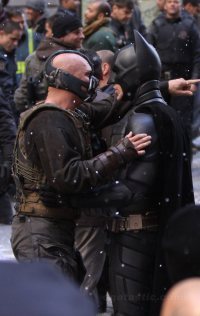 I for one look forward to seeing this movie, and not letting one bad review throw off my opinion of it or get me all worked up. Hell, even the last movie had its faults, but that didn’t take away from it being an awesome and memorable movie, especially where Heath’s portrayal was concerned. And if behind-the-scenes photos of Batman and Bane have taught us anything, it’s that even mortal enemies can kiss and make up! Seriously, check out these photos. Tell me that aint the perfect example of a heartwarming bromance!
I for one look forward to seeing this movie, and not letting one bad review throw off my opinion of it or get me all worked up. Hell, even the last movie had its faults, but that didn’t take away from it being an awesome and memorable movie, especially where Heath’s portrayal was concerned. And if behind-the-scenes photos of Batman and Bane have taught us anything, it’s that even mortal enemies can kiss and make up! Seriously, check out these photos. Tell me that aint the perfect example of a heartwarming bromance!
Update: In the course of writing this, I read about a terrible tragedy in Aurora, Colorado, where a gunman broke into a theater and shot up the premier of The Dark Knight Rises, killing 15 people and wounding at least 50. The man is in custody and frankly, I hope he faces the death penalty. Psycho bitch!


July 19, 2012
Starship Troopers: Invasion!
Fans of Starship Troopers must be sharing a collective “yahoo!” somewhere. It seems that Casper Van Diem – the actor who starred as Johnny Rico in the original movie and its horrid third installment – has decided to produce the fourth installment in the series. Like the second and third movies – both of which sucked hard ass! – this one will be straight to DVD.
But unlike the other two, this one will be an animated CGI feature, calling to mind the short-lived but decidedly unsucky animated series Roughnecks: The Starship Trooper Chronicles. The movie is schedules for release on August 28th, 2012, and in anticipation of this occasion, the studio has released a full-length, bad-ass trailer!
And judging from this little preview, this installment looks pretty good, combining the best elements from the original movie with a hardcore Halo feel! According to the studio, this movie takes place many years after the original, with all the characters from that movie (except for Dizzy Flores who died) reprising their roles. Carmen Ibanez is now Captain of her own battleships, Carl Jenkins is now Minister of Paranormal Warfare, and Johnny Rico is a general who comes out of retirement to command the Roughnecks for one last mission!
In fact, this sort of thing could be just what’s needed to help reboot the series. In spite of an adaptation that was big on flashy and low on substance, two sequels that were so atrocious they aren’t worth getting to, and an animated series that was terribly short on gore, this franchise actually has some potential. Bring on the bugs and automatic weapons fire!
[image error]
Via Blastr.com


The Future is Here: Aerographite!
 According to a recent story on CBC.ca, a new material has been developed which is the currently renowned for being the lightest material in the world. Known as Aerographite, the material is composed of carbon and weighs roughly one-seventy-fifth that of Styrofoam.
According to a recent story on CBC.ca, a new material has been developed which is the currently renowned for being the lightest material in the world. Known as Aerographite, the material is composed of carbon and weighs roughly one-seventy-fifth that of Styrofoam.
Created by researchers working at the Technical University of Hamburg-Harburg (TUHH) and Christian-Albrechts University of Kiel, this material is also said to be flexible, stable, water resistant, and a good conductor of electricity. It might sound like no big deal, but ultra-light substances that are composed of basic elements are things which were predicted to accompany the development of nanotechnology.
You see, at the micro level aerographite resembles a network of porous carbon tubes (pictured at right), which calls to mind the concept of the carbon nanotube. Much like the Buckminsterfullerene, this microscopic structure is predicted to be the mainstay of construction someday, just as soon as we can create nanomachines capable of erecting buildings!
And just think of it, diamonds are essentially carbon that has been layered and then super-compressed to become a near-indestructible material. If you have the ability to assemble tiny atomic structures made out of carbon, you can essentially create not only create diamonds, but also objects that are both extremely light and highly resilient. And just so you know, the researchers who produced aerographite have indicated that it can be compressed without damage.
Okay, it’s not exactly a technological revolution, but it is a step in that direction. Yep, soon enough we’ll be able to erect buildings simply by dumping some grey goo on the ground and watching a building sprout up. And unlike our current edifices of concrete, steel and glass, will be composed of different configurations of carbon and other primary elements. They will be stronger, lighter, able to endure indefinitely, maybe even capable of upgrades!


Of Terraforming
 Several scientific subjects have piqued my interest as of late, particularly the ones that relate to the colonization of other planets. And there are plenty of good reasons for this. First off, NASA has been talking at length about a possible Mars mission which will be begin in 2030. Second, the topic is central to the novel my group and I are writing. And third, because it’s what I do. I’m a geek, dammit! Do I really need any other reason?
Several scientific subjects have piqued my interest as of late, particularly the ones that relate to the colonization of other planets. And there are plenty of good reasons for this. First off, NASA has been talking at length about a possible Mars mission which will be begin in 2030. Second, the topic is central to the novel my group and I are writing. And third, because it’s what I do. I’m a geek, dammit! Do I really need any other reason?
So in honor of this fertile and increasingly relevant topic, I thought I’d dedicate a post to the science of terraforming and its depiction in popular culture. Like the majority of your more radical ideas, the concept first appeared around the turn of the 20th century. As part of the larger trend of exploring planetary colonization, several historical developments contributed to this phenomena.
Foremost amongst them was the closure of the American frontier by 1900 and the partitioning of Africa in 1905. With the “Age of Discovery” officially over, scientists and dreamers began to look farther abroad for the next place to move to. Refinements in the fields of metallurgy, chemistry, and astronomy also contributed to the idea that planets like the Moon, Mars, Venus, Europa, Ganymede, and even other star systems, could be colonized.
And thanks to the advent of the Space Race, the Apollo missions, and Eco-engineering in the latter half of the 20th century, scientists have begun to take a serious look at terraforming, particularly in regards to Mars. While the practicality, feasibility and affordability are all still being debated, the very fact that there is a serious scientific debate would seem to indicate that it may very well be done someday.
And so, here is a list of science fiction novels from the last century that have explored the idea of terraforming. Once again, I hope you enjoy reading about them as much as I enjoyed researching them, and incorporating some of what they taught me!
Last and First Men: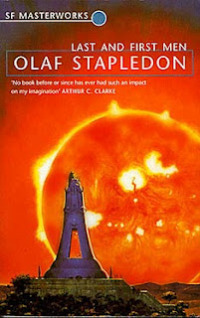 This future history by Olaf Stapledon, released in 1930, is the first time that the terraforming of Venus is made in fiction. This was only a fragment of the larger story, which focuses on human evolution over the course of two billions years. Nevertheless, the move to Venus is an intrinsic part of the story involving the “Fifth Men”, who are forced to relocate after Earth becoming uninhabitable.
This future history by Olaf Stapledon, released in 1930, is the first time that the terraforming of Venus is made in fiction. This was only a fragment of the larger story, which focuses on human evolution over the course of two billions years. Nevertheless, the move to Venus is an intrinsic part of the story involving the “Fifth Men”, who are forced to relocate after Earth becoming uninhabitable.
This occurs only after humanity pushes the local inhabitants to extinction after a protracted war. Afterward, they begin the process of transforming Venus to meet their needs. Like all early accounts, the description was hampered by the fact that knowledge of Venus was highly inaccurate. For example, Stapledon’s account has Venus covered in oceans, rather than the pits of sulfuric acid which are now known to be there.
Farmer in the Sky: 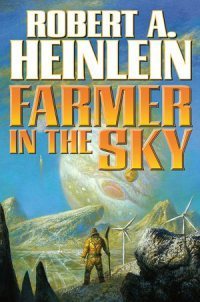 Here we have Robert A. Heinlein’s 1950 story which focuses on a family which has moved to Ganymede, which is in the process of being terraformed. Earth is overcrowded in this day and age, and farming colonies are being established in Jupiter’s moon to help provide much needed food supplies.
Here we have Robert A. Heinlein’s 1950 story which focuses on a family which has moved to Ganymede, which is in the process of being terraformed. Earth is overcrowded in this day and age, and farming colonies are being established in Jupiter’s moon to help provide much needed food supplies.
The process of creating the new farms is explained in some detail. For example, the topsoil is created from scratch by pulverizing boulders and lava flows, and seeding the resulting dust with carefully formulated organic material. Pressurized housing is erected to ensure that new arrivals are able to adjust, since the atmosphere is not fully breathable. And Ganymede is shielded from Jupiter’s intense radiation by a massive heat shield.
Hints are even given that establish that Ganymede once boasted an indigenous civilization, or was at least visited by one in the past. This includes a working land vehicle that has many legs, essentially a large metal centipede.
The Sands of Mars: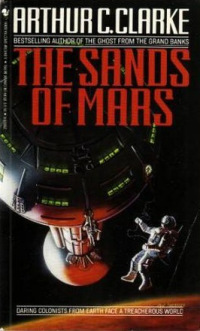 Next we have Arthur C. Clarke’s 1951 novel, which happened to be his first published work. And curiously enough, it is written from the point of view of a famous science fiction author. A case of art imitating life, or art as wish fulfillment? In any case, the setting is a research facility on Mars, which is in the process of terraforming so it will be able to become a self-sufficient colony.
Next we have Arthur C. Clarke’s 1951 novel, which happened to be his first published work. And curiously enough, it is written from the point of view of a famous science fiction author. A case of art imitating life, or art as wish fulfillment? In any case, the setting is a research facility on Mars, which is in the process of terraforming so it will be able to become a self-sufficient colony.
Based on Clarke’s descriptions, this terraforming process (known as “Project Dawn”) involves some rather curious steps. The first is the ignition of the moon Phobos so that it will become a second “sun” for Mars. It will burn for at least one thousand years and the extra heat, combined with the mass production of the oxygen-generating plants, will eventually make the Martian atmosphere breathable for humans.
In many respects, this served as a preview for the plot of 2001: A Space Odyssey and it’s sequel 2010: Odyssey Two (see below).
The Martian Way: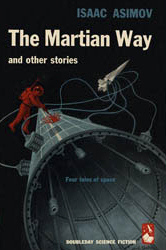 In keeping with the tradition of sci-fi greats, this next novel was written by Isaac Asimov and first published in 1952. The story is told from the point of view of Scavengers, Mars-born humans who spend their time scouring space for the spent lower stages of spacecraft. This sort of lifestyle, making do with less and toughing things out, is known as the “Martian Way”.
In keeping with the tradition of sci-fi greats, this next novel was written by Isaac Asimov and first published in 1952. The story is told from the point of view of Scavengers, Mars-born humans who spend their time scouring space for the spent lower stages of spacecraft. This sort of lifestyle, making do with less and toughing things out, is known as the “Martian Way”.
At this point, Mars is still very much dependent on Earth for water shipments, which are used for fuel as well as consumption. Life takes a turn for a worse when an ambitious Earth politician decides to cut of the “Wasters”. In response, the protagonists come up with an ambitious plan, to fly to Saturn’s Rings and tow back an asteroid made of pure ice.
The trip is difficult and takes many months, but the Martian Scavengers manage to snag an asteroid that will supply two hundred years worth of water. This, they begin to use to transform the ecology of Mars, and turn the tables on the Earth government.
The Psychotechnic League: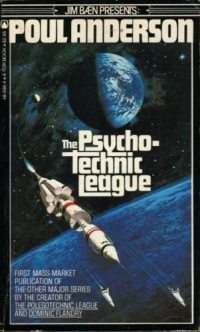 Written by Poul Anderson over the course of two decades, the Psychotechnic League refers to a series of novels and short stories that are set in the same universe. Of all these stories, two in particular deal with the terraforming of Solar Planets. In “The Big Rain”, Venus is being terraformed, a process of planetary engineering that takes several centuries to complete.
Written by Poul Anderson over the course of two decades, the Psychotechnic League refers to a series of novels and short stories that are set in the same universe. Of all these stories, two in particular deal with the terraforming of Solar Planets. In “The Big Rain”, Venus is being terraformed, a process of planetary engineering that takes several centuries to complete.
In “The Snows of Ganymede”, the focus shifts to the Jovian moon where scientists are able convert the planet to the point where it experiences seasons similar to Earth. This, in addition to Mars, Venus and several other Solar Planets, all come together in time to form the Solar Union. Because of Anderson’s realistic description, the term “big rain” became associated with scientific terraforming models.
The Space Odyssey Series: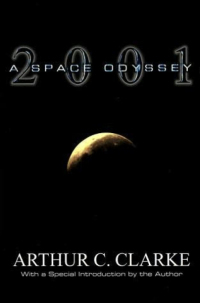 Arthur C. Clarke’s series, which began with the novelization of the classic film 2001: A Space Odyssey, revolves around the terraforming of Europa by a super advanced race. Known as the Firstborn, these aliens use the Monoliths to travel throughout the universe to foster the development of sentient life. Millions of years after fostering the development of high-order primates on Earth, they shifted their focus to Europa, Jupiter’s ice moon.
Arthur C. Clarke’s series, which began with the novelization of the classic film 2001: A Space Odyssey, revolves around the terraforming of Europa by a super advanced race. Known as the Firstborn, these aliens use the Monoliths to travel throughout the universe to foster the development of sentient life. Millions of years after fostering the development of high-order primates on Earth, they shifted their focus to Europa, Jupiter’s ice moon.
Much as in “Sands of Mars”, the process involved the creation of a “second sun”, this time involving Jupiter. In the first novel, the story ends with David Bowman, the only astronaut to survive an exploratory mission to Jupiter after their ships AI (the HAL 9000) malfunction and kills the crew.
When he arrives, he discovers a Monolith in orbit around Europa and disappears without a trace shortly thereafter.
In 2010: Odyssey Two, a second mission is mounted to determine the whereabouts of the first. When the joint US-Soviet mission arrives at Europa, they come to realize that the planet is showing signs of life. They also learn that the Monoliths are in the process of turning Jupiter into a sun so that Europa’s icy surface will evaporate and form an atmosphere, allowing all the life contained underneath to emerge and grow.
In the subsequent novels, Europa is revisited after its transformation is complete. Although sentient life does not appear to be possible, the planet does boast an atmosphere and vast oceans, which teem with sluggish sulfur-based lifeforms. In the end, after the Monoliths are convinced that humanity deserves a reprieve, and they land on Europe to commence building peaceful relations with the Europan life forms.
Mars Trilogy: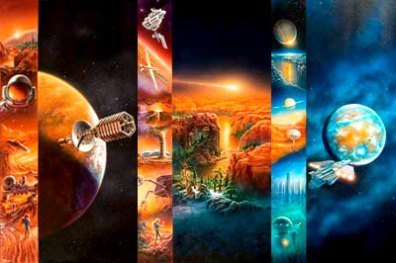 We finish with the most recent and profound example of all, the Mars Trilogy by Kim Stanley Robertason. The trilogy’s three works – Red Mars, Green Mars, Blue Mars – all focus on the ongoing efforts to transform Mars from an arid, hostile world with barely any atmosphere to a lush, hospitable planet capable of supporting human life.
We finish with the most recent and profound example of all, the Mars Trilogy by Kim Stanley Robertason. The trilogy’s three works – Red Mars, Green Mars, Blue Mars – all focus on the ongoing efforts to transform Mars from an arid, hostile world with barely any atmosphere to a lush, hospitable planet capable of supporting human life.
The first novel deals with the initial colonization effort, which begins with the crew of the Ares, a ship carrying 100 scientists drawn predominantly from the US and the Soviet Union. Upon arriving, the crew builds the first settlement, known as Underhill, as well as colonies on the hollowed out asteroid-moon of Phobos.
After debating what is to be done with Mars, whether to turn it “Green” or leave it “Red”, the United Nations Organization Mars Authority (UNOMA) eventually opts for the “Green” option and terraforming begins. This process involves the drilling of “moholes” in the surface to release subsurface heat to thicken the atmosphere and the detonation of nuclear devices deep in the sub-surface permafrost to release water.
Green Mars, which begins 50 years after events in the first novel, during the dawn of the 22nd century. At this point in time, the Martian landscape is evolving thanks to the expansion of plant life, hence the name. The process is stimulated though the use of continent-sized orbital mirrors which focus sunlight to and away from various sectors of the planet, to melting the northern polar ice cap, and digging moholes deep enough to form volcanoes.
In the third and final installment, Blue Mars, long-term terraforming has created atmospheric pressure and temperature conditions that allow for the presence of liquid water on the planet’s surface, forming rivers and seas. This all takes place over the course of the following century, long after Earth has flooded and revolutions have displaced corporate control of the planet. Because of this, Mars has become the principle planet of the Solar System.
Summary:
Terraforming efforts have come a long way in fiction, and hopefully some day soon they will be realizable. Even though the concept remains highly speculative at this point, all proposed efforts are currently focused on Mars. In all ways that count, Mars has everything we would need to make it suitable for human habitation. This includes water, in the presence of the frozen ice caps and possibly underground rivers, and high concentrations of carbon and oxygen in the form of CO2, nitrogen, and gravity to keep the atmosphere anchored.
And most importantly of all, Mars’ atmosphere closely resembles that of Earth several billions of years ago. In time, due to the development of photosynthetic bacteria, enough oxygen was produced to allow for the development of animals. Though the careful introduction of similar bacteria and plants to Mars surface, humans could speed that process along and eventually create a breathable atmosphere. This, in turn, will allow for the creation of an ozone layer and weather patterns. Combined with the melting of the polar ice and underground aquifers, this will lead to surface water in the form of rivers, streams and oceans.


July 18, 2012
Hyundai Zombie Survival Car





Hyundai has done it. They have created a Zombie Survival Car in the form of an apocalyptic souped up Elantra Coupe to celebrate the 100th issue of The Walking Dead comic. It comes complete with front spikes, wheel spikes, barred windows, and flood lights. Check it out! Also scroll to the bottom for a 5 minute video on how this beast was made.
A few weeks back, there was a story of how Walking Dead creator Robert Kirkman was going to unveil his new Zombie Car at the next Comic Con. It just landed!

